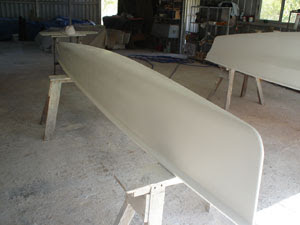
Recently I started building a Scarab 350 trimaran, a small boat designed for two people (ideally one adult and one child). Before I was finished I had many comments on the look of the boat and thought this could be a popular small trimaran to teach kids how to sale. Originally it was built to use as a tender for my dream catamaran. There is a need for a small trimaran to sail in local clubs in this area (SE Queensland) to rival the beach cats. The water of the Great Sandy Traits is conducive to small boat racing and the competition is high. The clubs at Hervey Bay and Tin Can Bay could be great places to race small trimarans. It is not economically feastible to build these boats commerically as a one-off. Ray designed a new boat the same length but round bilge with a folding system similiar to the Scarab 16 http://www.teamscarab.com.au/scarab16/pictures.html. This boat will be built using moulds so we can speed production. The name of the new boat is uncertain;we will have to reach a compromise. The plugs which will be used to create the moulds are partially built.








































